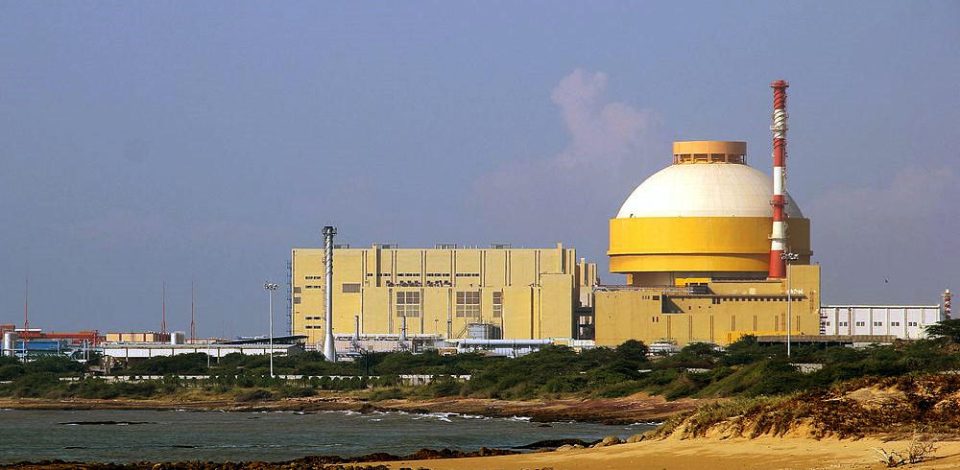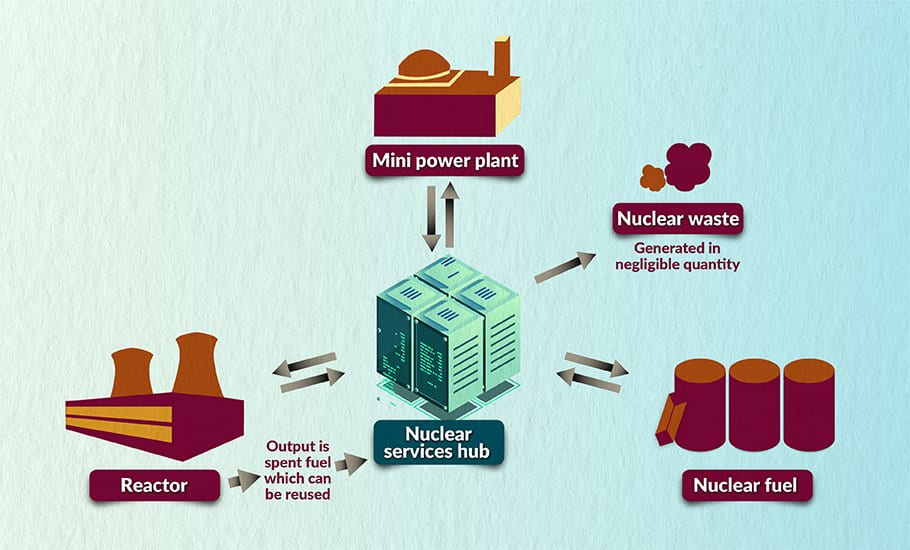
Spent fuel from nuclear plants is not a waste but a resource
Of late, there has been a lot of noise about the handling of spent fuel from the Kudankulam Nuclear Power Plant in Tamil Nadu

Of late, there has been a lot of noise about the handling of spent fuel from the Kudankulam Nuclear Power Plant, located close to Kanyakumari.
From the speaker of the Tamil Nadu Assembly to the Chief Minister, many have made remarks which, unfortunately, do not give a clear understanding of the subject and need clarification.
First, let us understand the questions and seek answers from a scientific viewpoint.
What happens inside a nuclear reactor?
All reactors have fuel in the form of tubes. The tubes contain pellets with enriched Uranium (U235) oxide inside. Heat or energy is generated by fission with bombarding neutrons. Natural Uranium contains a very small percentage of U235 and its proportion needs to be increased to five to seven per cent to make it usable as fuel.
The energy of the released fission products is enormous and is meant to generate power using turbines. After being used for several months, the fuel is no longer productive and is categorised as spent fuel. The old rods are then removed and replaced with new ones for further power generation. In a nutshell, this is all that happens inside a nuclear reactor.
How is nuclear waste different from spent fuel?
The spent fuel, in the form of removed rods, is kept in water pools in the vicinity of the reactor for a long period of time and then shifted to Away From Reactor (AFR) sites, where it is reprocessed.
Also read: Ukrainian residents stop Russian forces from taking over nuclear power plant
Notably, there are differences between reactor types used in Kalpakkam and Kudankulam plants (both located in Tamil Nadu).

The Kudankulam unit is known as VVER (and is not the type used in Chernobyl in Russia). The difference lies in the need to enrich Uranium, which is not the case with the reactor at Kalpakkam. Besides, the moderator used to control the reactions are different.
That way, the Kudankulam units are not that different from other reactors in India. Reprocessing is a method by which fissionable Plutonium and other radioactive substances are removed from the irradiated nuclear fuel.
After reprocessing and extracting Uranium and Plutonium, besides Cesium 137, Strontium 90 and other useful isotopes, the leftover is a small quantity which is stored in vitrified glass for long-term storage. This is the stage when the question of underground repository comes up. It is a challenge not yet settled by any country.
Several countries like Russia, China, France and India reprocess the spent fuel, while the US prohibits it by law for its own reasons. Hence, for the US it is a serious problem to handle large amounts of spent fuel which is then looked upon as waste. The US is also yet to address the challenge of underground storage repository.
Spent fuel needs to be shielded and cooled
Spent fuel in the initial rods removed from the reactors after the fission cycle and is no longer useful for that purpose. It is kept in water pools at the reactor site — shielded and cooled. Pools of water are at least 20 feet in depth with assemblies at the bottom. Also, care needs to be taken that radioactive material does not contaminate the surrounding area.
The new spent fuel replaces the old one periodically after being removed for reprocessing. Additionally, there are challenges in removing defective or leaking fuel rods which should be done extremely carefully before placing them under the water pool to avoid contamination.
Water primarily cools the hot fuel rod and protects the environment from radiation. There are other methods of handling spent fuel from the reactor as well, but that is beyond the scope of this article.
What happens during reprocessing of spent fuel?
During reprocessing, Plutonium and Uranium (U238) are extracted for further use along with other useful isotopes. Long-lived nuclides are converted to short-lived ones through nuclear incineration and the volume of waste is thus reduced. Handling the waste becomes a challenge for which an underground repository will be needed. Fortunately, the need for addressing this question has not risen yet.
Now, let’s talk about the Kudankulam reactor. As mentioned earlier, its design is different from the other nuclear reactors found in India. Rest of the plants are Pressurised Heavy water reactors (PHWR), where Heavy water is used to control the fission going out of control. Heavy water incidentally has the isotope Deuterium (D2O) instead of hydrogen, which is present in normal water (H2O). The Kudankulam reactor uses enriched Uranium and normal water (also known as VVER – Vada Vada Energy reactor. In Russian, Vada stands for Water!). Uranium for this is supplied by Russia.
Digging a little deeper into the history of the Kudankulam reactor will help us understand its working better.
- The current proposal is to have 6 plants of 1,000 MW each. The first and second were a result of the Rajiv Gandhi- Gorbachov agreement of 1988. After the collapse of the Soviet Union in 1990, the agreement was shelved. It was revived later in 2002 though the US objected to it. Russia, which needed huge foreign exchange, quoted what is euphemistically called ‘Grand-father clause’, namely the previous agreement, and proceeded with the supply.
2. Rest of the plants were offshoots of the 123 nuclear deal between India and US with clearance from the Nuclear Supplier Group (NSG). India got exemption from sanctions (imposed after the Pokhran test) to import Uranium which was a major advantage.
3. Those plants which got Uranium through imports were kept under IAEA (International Atomic Energy Agency) inspection. Since Uranium for the Kudankulam reactor was supplied by Russia, it is under IAEA inspection.
4. The 1988 agreement had a clause for transport of the spent fuel back to the erstwhile Soviet Union. Practically, this would have created huge transport problems during transition in the seas. The agreement was modified in 2002 and accordingly the spent fuel is to be kept in Kudankulam itself.
5. Coming back to spent fuel, we should realise that only one per cent of the nuclear material is used in the reactor and a large part of the rest can still be utilised after reprocessing.
6. It is a misnomer to call it a waste, and the correct term is only spent fuel.
7. Reprocessed extracts of Uranium and Plutonium also have the potential to be used in making a bomb. Hence, there are restrictions for reprocessing in many countries. Needless to say, this reprocessed material is used for various products including fuel for the breeder reactor, which is known as the second stage of the nuclear program in India.
8. Plutonium is extracted from the spent fuel in other reactors in India.
9. Plutonium can be used in the Fast Breeder Reactor at Kalpakkam. There was a (small) test reactor (FBTR, 40MW) constructed which functioned satisfactorily.
10. The design of the 700 MW fast breeder reactor (FBR), known as Bhavini, is having problems and is still to be made critical (the stage where the reactor is ready to generate electricity).
The FBR in Kalpakkam will use mixed oxide of Pu-239 (obtained from reprocessed spent fuel from the PHWRs) and Uranium-238 as fuel to generate energy. This nuclear reaction will also produce more Pu-239 by converting both U-238 in the fuel mix, as well as a blanket of depleted Uranium surrounding the core, into more plutonium.
Due to the presence of liquid sodium coolant in these reactors, extreme care needs to be exercised. Because sodium is an extremely reactive material and reacts violently with water and air, it has to be kept in a high concentration of inert atmosphere. Successfully handling liquid sodium is a serious challenge and it may take some time to address it. But no doubt it should be resolved indigenously because no country has successfully mastered the art so far.
About Kudankulam reactor and how it is different from others
As explained earlier, the Kudankulam reactor is a different design from reactors in Kalpakkam, Kaiga, Kakrapur, Rawatpur and Narora (indigenously designed). These plants are Pressurised Heavy water reactors (PHWR). The plants at Kalpakkam (Kaiga, Kakrapur, Rawatpur and Narora later) had started with Canadian assistance. However, after the Pokran I test in 1974, Canada withdrew support and India had to complete the Kalpakkam units with indigenous efforts.
Also read: TN may soon be the largest source of nuclear energy in India
Now coming to Away From Reactor (AFR) spent fuel storage. It should be realised that such a facility already exists in Indian reactor sites. To that extent, this is not new. The first two plants at Kudankulam had spent fuel kept in storage pools for the past several years. They must have sufficiently cooled and can be kept in storage places inside the complex, but away from the reactor to make way for the new spent fuel coming out of the reactors.
AFR is also specific to the reactor type and the fuel used. AFR at Kudankulam cannot be used for spent fuel from other plants. There is no clarity about the current status of the agreement for reprocessing the spent fuel since Kudankulam comes under IAEA safeguards.
The earlier Rajiv Gandhi-Gorbachav agreement was modified in 2002 to keep the fuel in the reactor site itself instead of transporting it to Russia. Till a clarity on spent fuel for reprocessing for all the reactors coming under the 123 agreement and IAEA safeguard is obtained, they need to be protected in the complex but away from the reactor. Still, that is not a ‘waste handling’ problem.
They can be safely kept without any risk of radiation risk to the environment or to people living close by. It is not an immediate concern.
Also read: Nuclear energy gets a seat at COP26 table; to be part of solution to climate change
Instead, international agreements have to be made for safe reprocessing and further peaceful use of nuclear material.
If such a scheme works out and also the FBR reactor, ‘Bhavini’ at Kalpakkam, becomes successful, these questions will eventually have a natural and satisfactory solution. The challenge of waste disposal in underground repositories too will be addressed gradually.


